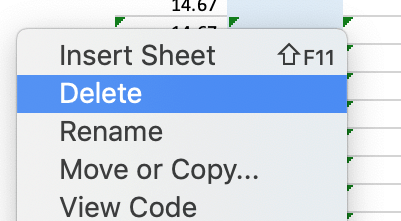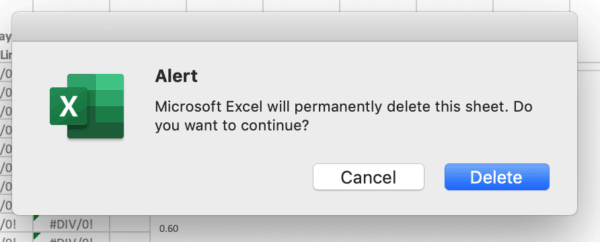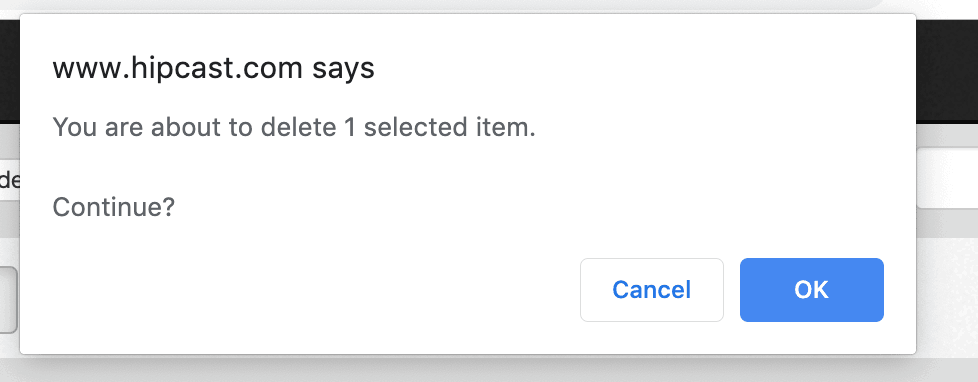Lean focuses on making it easy for people to do the right thing. We also work hard to “error proof” processes and our work to make it difficult, if not impossible to do the wrong thing.
The Throwback Thursday portion of this post looks back at a time when American Airlines took my suggestion and made it harder to do the wrong thing:
And here's a good example of error proofing online:
The other day, I was writing a blog post (to be published in the future) that involved many charts and graphs. So, I was using Microsoft Excel (my spreadsheet tool of choice unless I'm collaborating with others, then I use Google Sheets).
My intent was to copy an existing tab to create a new one.
My finger slipped on the trackpad, I guess, and I accidentally DELETED the tab.

I hit Command-Z, the keyboard shortcut on my Mac. Nothing happened.
I hit Undo in the menu bar. Nothing.
You can't undo this??
I searched online and there's apparently no way to Undo that. See this post for an example. The best you can hope to do is recover it from a saved version of the spreadsheet, but that wasn't an option for me. The tab I deleted was relatively new, so it wasn't in a saved version.
“Autosave” was not enabled, for some reason. That would have helped. Excel wouldn't let me toggle on Autosave as a corrective action for future circumstances. I don't know the root cause of why Autosave wasn't on.

This seems like a bug… the software says AutoSave should be on by default, but it is not.

This seems to be a “known issue.” Ugh. I'll have to dig into that later.
WORKAROUND: Hit “Command-S” more often to save more often. I'd predict this countermeasure won't always happen.
It seems like particular cruel design and a bad User Interface to put “Insert Sheet” and Delete right next to each other, especially when there's no confirmation step required to Delete.

There's no “Are you sure?” dialog box (but I'm sure I've complained about those before).
Or so I thought… I”ve been playing around with this a lot (after saving) I swear that there are times when there's no dialog box and times when there is one. This could be cognitive error on my part.

That could be a situation where somebody accidentally hits “Cancel” — we've all misclicked for one reason or another. I still don't understand why this can't be undone.
PREDICTION: I'll make this mistake again sometime.
WORKAROUND: Use Shift-F11 to insert a new sheet, to avoid accidentally hitting Delete. There's no keyboard shortcut for “Move or Copy,” which is something I do a lot.
Fixing the software would be more effective than me hanging a poster about being careful or slowing down when I work.
When I tweeted about this, I got some other examples from people, including this one:
In VS Code, you edit a filename by right clicking -> rename -> type the new name. If you hit backspace while not in the rename mode, it deletes your file with no undo.
— Jacob Paris (@jacobmparis) April 30, 2019
The only way to get it back is to go to the trash and copy it back over, and if you're lucky it's only one file
Are there software applications that you work with that lack basic error proofing? I'm expecting to get stories about Electronic Medical Record / Electronic Health Record systems.
Update: I was working in the Hipcast.com podcast platform, as I finalize moving my podcasts after their huge technical problems (as I blogged about).
One thing we had years ago was a KaiNexus “video podcast.” Yeah, I can barely remember that “video podcasts” were a thing. That's now all done through YouTube and our KaiNexus instructional videos on Kaizen have also been there for years.
So, the KaiNexus team agreed I could just end the video podcast series, which meant deleting it from Hipcast.
This required one click to the left of the podcast…

And a click up top on “Delete” which brought up a dialog box:

Like the American Airlines case, the confirmation doesn't say WHICH selected item. So, I scrolled back down to double check. It would be a bad mistake on my part to delete the wrong podcast (even after things have been moved to the new podcast hosts… I have reasons to not immediately cancel my Hipcast.com account.
Again, compare that to how my website host, WP Engine, handles deletions.
Again, this could be error proofed with a little bit of effort, as American Airlines thankfully did.
Please scroll down (or click) to post a comment. Connect with me on LinkedIn.
Let’s work together to build a culture of continuous improvement and psychological safety. If you're a leader looking to create lasting change—not just projects—I help organizations:
- Engage people at all levels in sustainable improvement
- Shift from fear of mistakes to learning from them
- Apply Lean thinking in practical, people-centered ways
Interested in coaching or a keynote talk? Let’s start a conversation.








![When Was the Last Time a Leader Around You Admitted They Were Wrong? [Poll]](https://www.leanblog.org/wp-content/uploads/2025/07/Lean-Blog-Post-Cover-Image-2025-07-01T212509.843-100x75.jpg)

This is not exactly a keyboard shortcut, and I’m not sure exactly how it works on Mac, but here are some other options for working with sheets that might be less error-prone: https://www.ablebits.com/office-addins-blog/2018/12/12/copy-move-sheet-excel/
Thanks. The “click and drag” method and the ‘toolbar’ method seem far less error-prone, especially since the toolbar doesn’t put “move/copy” very close to delete.
I also wouldn’t have expected “organize” to be under the “format” menu.
Because deleting a sheet can create havoc for a user, Excel should have prompted you (just like closing a workbook without saving) and forced you to press Delete in a dialog box. I looked in Advanced Settings and could not find anything that would allow a user to disable this.
This is a fantastic example of applying lean principles in the field of informatics. Some colleagues and I presented last month at the ANIA (Amer. Nursing Informatics Association) annual conference, and challenged attendees to volunteer examples of mistake proofing that they see or have implemented in their electronic medical records and other systems/tools we use in healthcare, especially as they support good processes. This would have been such a simple, familiar example! What a great illustration of the mistake proofing concept, and that it can be applied in most contexts, not just gas valves and centrifuges.
Also: So sorry you lost your worksheet. I’ve been there, and that’s a serious bummer.
Thanks, Lauren.
Do you see more examples of “good error proofing” or “needs more error proofing” in EHRs?
I only hear complaints and horror stories… since I’m not an EHR user, obvious. At most, I use the patient EPIC app through primary care.